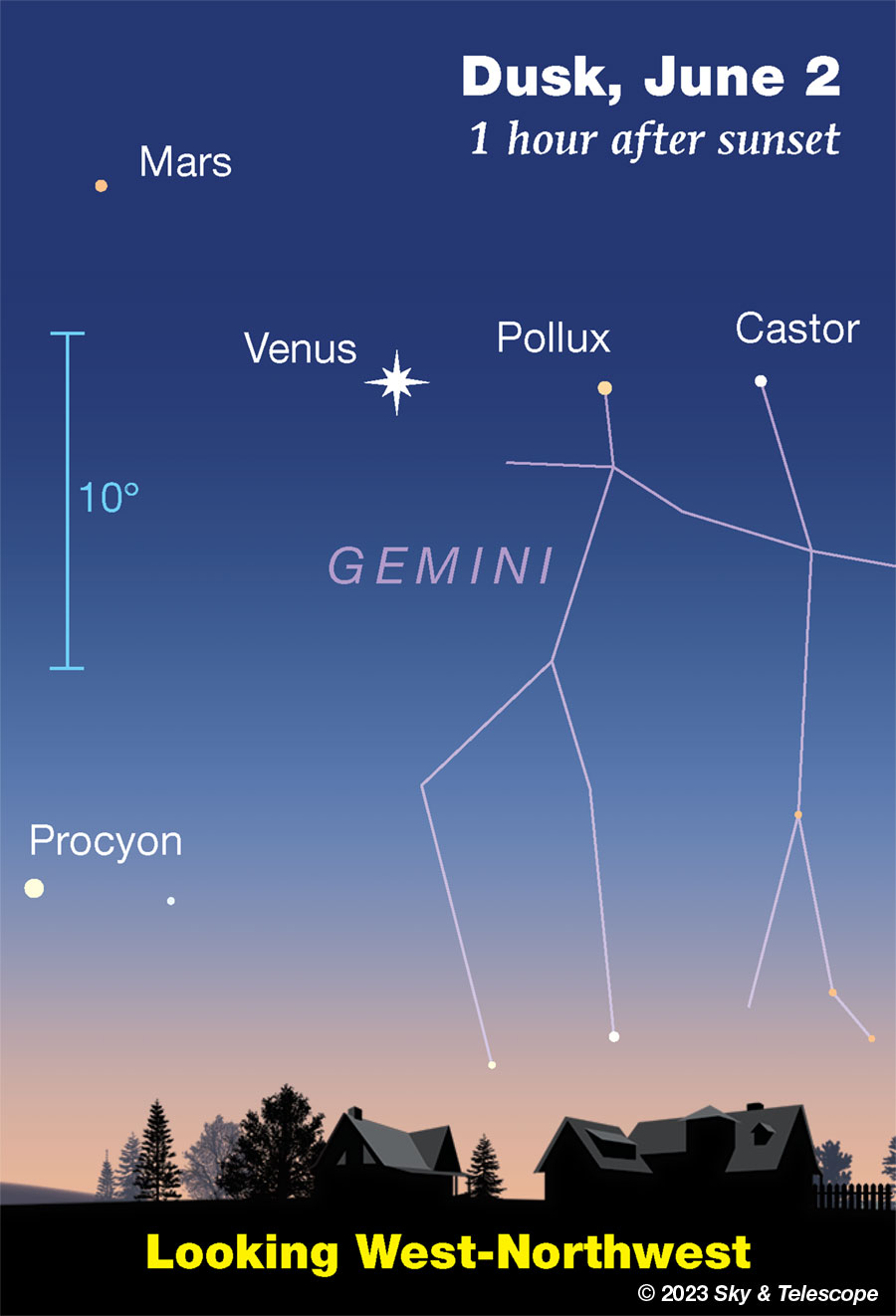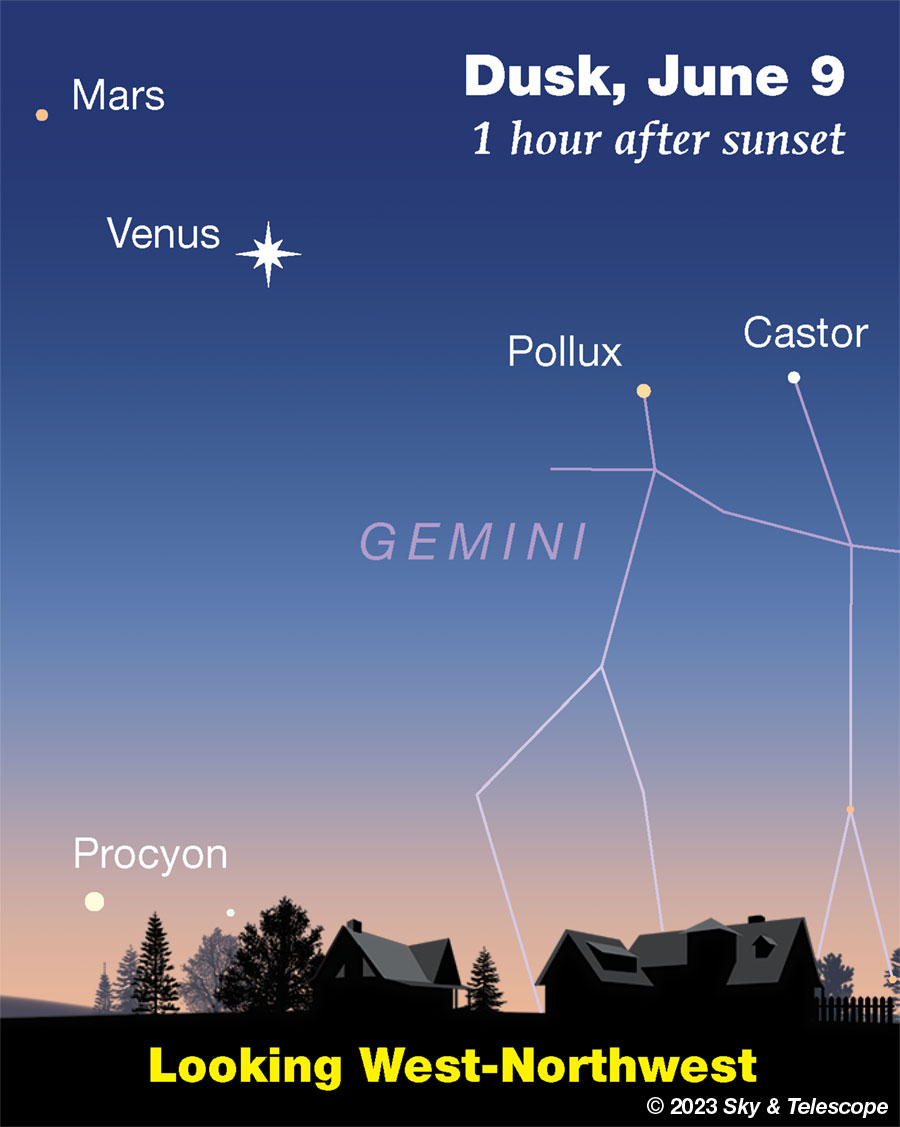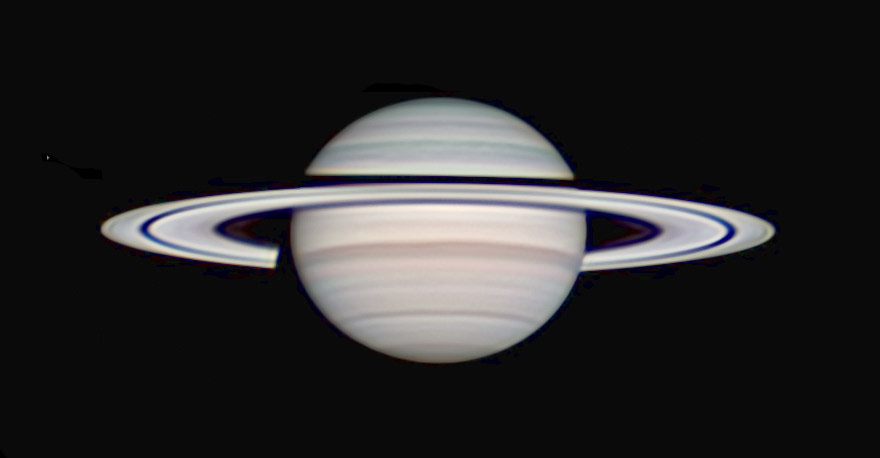Supernova in the Pinwheel Galaxy, update June 7: The sky is now moonless after dark. And Supernova 2023ixf in the galaxy M101 has only faded a trace, to magnitude 11.3, from its peak of magnitude 11.1 around May 25th.
Supernovae usually stay bright for weeks, often with ups and downs, so there's no telling what this one may do next. See our article Bright Supernova Blazes in M101, the Pinwheel Galaxy, with charts and comparison magnitudes. See a star, a single star, 21 million light-years away.
FRIDAY, JUNE 2
■ Venus remains in line with Castor and Pollux this evening, as shown below, though not as precisely as it was yesterday evening. During the course of this week, watch the two stars move farther to Venus's lower right, while Mars approaches Venus more slowly from the upper left.

■ Mars shines inside the Beehive cluster, M44, near the central beehive-shaped asterism itself (which is currently tilted right). Use binoculars after twilight ends or, better, a telescope.
Mars is moving east across the cluster at about 90 arcseconds per hour. Can you see its position change with respect to the stars in as little as a half hour? Note the shape it makes with the closest faint stars to it that you can see, as noted in the June Sky & Telescope, page 49.
Venus will follow in Mars's footsteps past the Beehive on June 12th and 13th.
SATURDAY, JUNE 3
■ Full Moon (exact at 11:43 p.m. EDT). Look for orange Antares just 3° or 4° to the Moon's upper right this evening. Binoculars will help pull Antares out of the bright moonglare.
And upper right of Antares by 7½° is Delta Scorpii, about half as bright but less blasted by moonlight. Delta Sco is the middle, and brightest, of the three stars forming the head of Scorpius. Use those binocs.
SUNDAY, JUNE 4
■ Vega is the brightest star in the east-northeast after dark. Look 14° (about a fist and a half at arm's length) to Vega's upper left for Eltanin, the 2nd-magnitude nose of Draco the Dragon. Closer above and upper left of Eltanin are the three fainter stars forming the rest of Draco's stick-figure head, also called the Lozenge; the faintest of them is 4th magnitude. Draco always points his nose to Vega.
MONDAY, JUNE 5
■ Bright Arcturus shines pale yellow-orange high overhead toward the south these evenings. The kite shape of Boötes, its constellation, extends up from Arcturus as you face south. The kite is narrow, slightly bent to the right, and 23° long: about two fists at arm's length.
TUESDAY, JUNE 6
■ As we count down the last two weeks to official summer (the solstice is on June 21st this year), the Summer Triangle stands high and proud in the east after dark. Its top star is bright Vega. Deneb is the brightest star to Vega's lower left, by 2 or 3 fists at arm's length. Look for Altair a greater distance to Vega's lower right. Altair is midway in brightness between Vega and Deneb.
WEDNESDAY JUNE 7
■ Leo's tail star, 2nd-magnitude Denebola high in the south-southwest after dark, forms an almost perfectly equilateral triangle with brighter Spica off to its left and Arcturus, brighter still, above them. All three sides of the triangle are close to 35° long (35.3°, 35.1°, and 32.8°). S&T columnist George Lovi named this the Spring Triangle nearly a half century ago, but the name never really caught on. For such a near-perfect equilateral, I think its special name ought to be revived.
THURSDAY, JUNE 8
■ Vega is the brightest star high in the east after dark. Barely lower left of it is 4th-magnitude Epsilon Lyrae, the Double-Double. Epsilon forms one corner of a roughly equilateral triangle with Vega and Zeta Lyrae. The triangle is less than 2° on a side, hardly the width of your thumb at arm's length.
Binoculars easily resolve Epsilon. And a 4-inch telescope at 100× or more should resolve each of Epsilon's wide components into a tight pair.
Zeta Lyrae is also a double star for binoculars; much tougher, but plainly resolved in any telescope.
Delta Lyrae, below Zeta, is a much wider and easier pair, orange and blue.
FRIDAY, JUNE 9
■ The Big Dipper hangs high in the northwest as the stars come out. The Dipper's Pointers, currently its bottom two stars, point lower right toward Polaris. Above Polaris, and looking very similar to it, is Kochab, the lip of the Little Dipper's bowl. (The rest of the Little Dipper is mostly dim.)
Kochab stands precisely above Polaris around the end of twilight or a little after. How accurately can you time this event for your location, perhaps using the vertical edge of a building?

■ Saturn rises around 1 a.m. Saturday morning (daylight-saving time), followed less than a half hour later by the Moon, nearly last quarter and 6° or 7° to Saturn's lower left. By early dawn the two of them are well up in the southeast.
SATURDAY, JUNE 10
■ Spica is straight below Arcturus not long after dark. Half as far to Spica's lower right is the four-star pattern of Corvus, the springtime Crow, rather compact. Spring will soon be over; catch Corvus before it sinks too low and departs from the evening sky until next year.
■ Last-quarter Moon (exact at 3:31 p.m. EDT). The Moon rises tonight around 2 a.m. daylight-saving time, lower right of the Great Square of Pegasus and lower left of Saturn.
SUNDAY, JUNE 11
■ Here it is almost summer. But as twilight fades, look very low in the north-northwest for wintry Capella very out of season. The farther north you are, the less low it will appear. You may need binoculars. If you're as far north as Montreal or either of the Portlands (Oregon and Maine), Capella is actually circumpolar.
This Week's Planet Roundup
Mercury is deep in the glow of sunrise, brightening from magnitude +0.2 to –0.3 this week. Use binoculars to try for it well to the lower left of brighter Jupiter. They're moving apart, from 15° separation on the morning of June 3rd to 22° on the 10th.
Venus (magnitude –4.4, in Cancer) is the brilliant "Evening Star" in the west from twilight into late evening. It's not quite as high in the dusk as it was a couple weeks ago, but it doesn't set until about 1½ hours after full dark.
Venus starts the week still nearly in line with Castor and Pollux, then moves farther out of line every day.
In a telescope Venus is a dazzling little half-Moon shape, just starting to show signs of turning into a fat crescent. It enlarges a little every day while waning in phase. Venus will become a bigger, thinning crescent dropping lower until it's lost from sight in mid- to late July.
Mars (magnitude 1.6, in Cancer) glows weakly to the upper left of Venus, by a slowly shrinking distance: 10° on the evening of June 2nd, 8° by June 9th. That's not quite a fist at arm's length.
But no conjunction is in store. Mars and Venus will reach a minimum separation of 3.6° on June 30th, then they'll start to draw apart again as Venus plunges down toward the sunset. This is called a quasi-conjunction, because they don't pass each other although they do get within 5° of each other.
In a telescope Mars is just a tiny little blob 4½ arcseconds in diameter, since it's on the far side of its orbit from us.
Jupiter (magnitude –2.1, in Aries) is low in the east as dawn brightens. It might be easiest to see about 60 to 45 minutes before sunrise.
Saturn (magnitude +1.0, in dim Aquarius) is well up in the southeast by the beginning of dawn.

Also notice the black on each side of the rings where they cross the planet's disk. The dark black south of (above) the rings is their shadow on the globe. The thinner, slightly grayer black to their north is the dim, sparse inner C ring, seen in front of the planet's bright face.
Uranus, magnitude 5.9, is hidden low in the sunrise.
Neptune, magnitude 7.9 at the Aquarius-Pisces border, is low in the east-southeast before dawn begins.
All descriptions that relate to your horizon — including the words up, down, right, and left — are written for the world's mid-northern latitudes. Descriptions and graphics that also depend on longitude (mainly Moon positions) are for North America.
Eastern Daylight Time (EDT) is Universal Time minus 4 hours. UT is sometimes called UTC, GMT, or Z time.
Want to become a better astronomer? Learn your way around the constellations. They're the key to locating everything fainter and deeper to hunt with binoculars or a telescope.
This is an outdoor nature hobby. For a more detailed constellation guide covering the whole evening sky, use the big monthly map in the center of each issue of Sky & Telescope, the essential magazine of astronomy.
Once you get a telescope, to put it to good use you'll need a much more detailed, large-scale sky atlas (set of charts). The basic standard is the Pocket Sky Atlas (in either the original or Jumbo Edition), which shows all stars to magnitude 7.6.

Next up is the larger and deeper Sky Atlas 2000.0, plotting stars to magnitude 8.5; nearly three times as many. The next up, once you know your way around, are the even larger Interstellarum atlas (stars to magnitude 9.5) or Uranometria 2000.0 (stars to mag 9.75). And be sure to read How to Use a Star Chart with a Telescope. It applies just as much to charts on your phone or tablet as to charts on paper.
You'll also want a good deep-sky guidebook. A beloved old classic is the three-volume Burnham's Celestial Handbook. An impressive more modern one is the big Night Sky Observer's Guide set (2+ volumes) by Kepple and Sanner.
Can a computerized telescope replace charts? Not for beginners, I don't think, and not on mounts and tripods that are less than top-quality mechanically. And as Terence Dickinson and Alan Dyer say in their Backyard Astronomer's Guide, "A full appreciation of the universe cannot come without developing the skills to find things in the sky and understanding how the sky works. This knowledge comes only by spending time under the stars with star maps in hand."
![]() Audio sky tour. Out under the evening sky with your
Audio sky tour. Out under the evening sky with your
earbuds in place, listen to Kelly Beatty's monthly
podcast tour of the heavens above. It's free.
"The dangers of not thinking clearly are much greater now than ever before. It's not that there's something new in our way of thinking, it's that credulous and confused thinking can be much more lethal in ways it was never before."
— Carl Sagan, 1996
"Facts are stubborn things."
— John Adams, 1770
 10
10
Comments
misha17
June 2, 2023 at 12:24 pm
Earliest sunrise for Northern Hemisphere viewers occurs next weekend, even though the solstice will still be over a week away. Sunset continue to occur later each evening, compensating for the (slight) loss of "morning" daylight.
The loss of morning daylight is an illusion: Solar Noon - the instant when the Sun is due South - is occurring later than Civil Noon (12:00) this time of year, so even though the time between Sunrise and Solar Noon will continue to increase until the Solstice, that those additional minutes will occur after Civil Noon.
You must be logged in to post a comment.
misha17
June 2, 2023 at 1:00 pm
1. I just checked: until early June, Solar Noon had been occurring before 12:00 (Standard Time)*, and will now begin occurring after 12:00.
Solar Noon will occur after 12:00 (Stanard Time)* until September.
Since "P.M." is an abbreviation for the Latin phrase "post meridian" ("after meridian [crossing]"), from June through September there will be a few minutes of "12:mm P.M." where the Sun will technically be "~before~ the meridian crossing".
2. * The actual date when Solar Noon occurs at 12:00 depends on whether a location lies East or West of its time zone's central meridian
(120° for Pacific Time, 75° for Eastern Time, etc.).
And don't forget to allow for Daylight Saving Time!
You must be logged in to post a comment.
mary beth
June 3, 2023 at 12:59 am
Here in Houston the closest we ever have solar noon to clock noon is for ten days, October 26 through November 11, when it’s 4 minutes past noon (standard time).
You must be logged in to post a comment.
Rod
June 2, 2023 at 1:19 pm
Very nice misha17. Last night I did get out and enjoy some stargazing, viewing Mars moving towards and passing through M44, the Beehive cluster. Some smoke from NJ was over my area too (MD) 🙂
Observed 2000-2130 EDT. Sunset near 2026 EDT, Moon waxing gibbous in Libra, Full Moon 04-June-2023 0342 UT. I used 10x50 binoculars and my 90-mm refractor telescope. Mars passing through M44 in Cancer, Venus in Gemini. Mars and M44 angular separation about 0.5-degrees or just less than 32 arcminutes in the sky as Mars passes through M44. Both Mars and M44 fit into the FOV at 25x, 71x, and 111x. The TeleVue 14-mm Delos at 71x provided a very nice view of the pair and the TeleVue 40-mm plossl at 25x too. Mars is a bit more than 2 au distance, M44 some 577 light-years according to Stellarium 23.1. There was some high smoke passing over tonight, local NBC weather reported the smoke came from NJ Before sunset I looked at the Moon at 25x, Tycho crater with rays easy, Copernicus, other craters like Eratosthenes, Aristarchus, Archimedes. No filter needed when looking at the Moon before sunset and shortly after. Venus at 25x to 111x, distinct half-moon shape, about 51% illuminated and nearly 23 arcsecond angular size so easy to see at 25x to 111x observations. Mars and M44 became visible 2100 EDT using my telescope, spotted with binoculars first. Mars’ planetary shape visible at 71x and 111x (but small and no features). There were several bats flying around. Later in the evening June fireflies appeared in the fields and woods. Clear skies except for high smoke from NJ apparently, temperature 19C.
You must be logged in to post a comment.
Rod
June 2, 2023 at 1:40 pm
Some of this smoke from NJ made it down to MD yesterday and in the evening while I was out in the pastures observing. https://www.cbsnews.com/philadelphia/news/air-quality-alerts-delaware-new-jersey-pennsylvania-allen-road-bass-river-nj-nova-scotia-wildfires/
You must be logged in to post a comment.
New Jersey Eclipse Fan
June 2, 2023 at 7:57 pm
On behalf of the Garden State, I humbly apologize for the interference of "our" smoke on your sky-watching efforts. However, if it enhances your sunrise & sunset viewing, then you're welcome! 😉
You must be logged in to post a comment.
Rod
June 2, 2023 at 9:38 pm
LoL 🙂 The sunset last night was quite nice 🙂
You must be logged in to post a comment.
Rod
June 6, 2023 at 4:35 pm
Here in MD, not seeing much now. Canada smoke is over the area today.
https://www.msn.com/en-us/news/us/smoke-invaded-the-d-c-area-yet-again-tuesday-and-could-get-worse/ar-AA1cdgw6?ocid=msedgdhp&pc=U531&cvid=407eafff30b1464bb52eadaf8a9532ec&ei=7
You must be logged in to post a comment.
mary beth
June 6, 2023 at 5:22 pm
At least New Jersey Eclipse Fan is off the hook!
We’ve had some beautiful weather, but it’s cloudy today. Most evenings we’ve been enjoying Antares, and watching Spica crossing the meridian. The full Strawberry Moon was so gorgeous! We had a much better view the night before full, but it pretty much appeared full Friday. On Saturday clouds rolled in right when it was rising, but I still got to see the entire surface when it was that deep orange. Minutes later it was obscured.
Hope the smoke clears soon Rod…. is there any prediction on when things will get better?
You must be logged in to post a comment.
Rod
June 7, 2023 at 6:11 am
maybe this weekend but more clouds too. Perhaps the end is near 🙂
You must be logged in to post a comment.
You must be logged in to post a comment.